News & Reviews
We love sharing our wines and our favourite parts of our beautiful Kangaroo Island. Our blog shares our team's favourite ways to get the most from your visit when you're exploring Kangaroo Island. And of course we like to share the latest news and wine reviews with you too!
Vintage 2022 report. Getting back to business.

Vintage 2022 has been an enormous milestone in our recovery from the 2019/2020 bushfires, which devastated our estate in the stunning Kohinoor Hills on Kangaroo Island.
We were excited to be back producing again at our home winery & buoyed by the recovery of our vineyard.
With international covid restrictions easing, Jacques Lurton was back on deck on Kangaroo Island to kick off vintage.
Having our dream team back together felt so good!
Growing Season
Kangaroo Island experienced a wet winter in 2021, followed by a challenging flowering during November. These same conditions were experienced across much of South Australia, resulting in widespread lower fruit-set.

Ripening
As always in viticulture, every challenge has a silver lining. As a result of the below-average flowering, our vines concentrated their energy on a smaller amount of fruit. Summer 2021/2022 has been mild, creating a long slow ripening period resulting in red varieties with an outstanding balance of fruit & acidity.
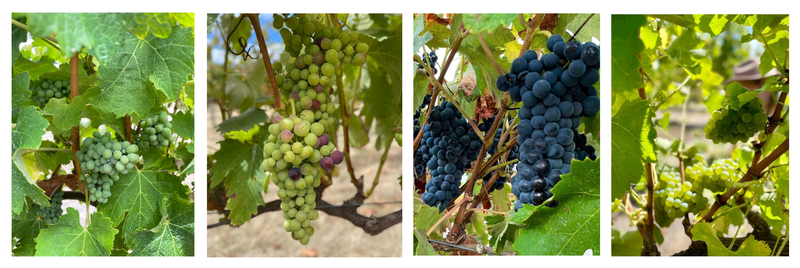
Harvest
Harvest kicked off on the 10th of March with a small crew hand-picking an excellent crop of Sauvignon Blanc at the Haines vineyard. Over the next 5 weeks, we processed around 70 tonnes of grapes concluding with a hand-pick of our signature variety Cabernet Franc on the 14th of April. We celebrated our first harvest from our Kohinoor Hills vineyard with two volunteer picking days where we were joined by friends, community members & loyal customers.
It was exciting & energising to be harvesting from our estate just two years post bushfire. Our yield was small compared to pre-bushfire levels, but we are confident our recovery rate will improve significantly over the next two years.


As always in a small wine business, vintage means all hands on deck. The entire Norris family jumped in for long days & even longer nights. Yale's son Wynn became the #1 vintage hand. A next-generation winemaker in the making! And it was wonderful to have Jacques' wife Natalie Lurton join our picking team.

Winemaking
It is energising to have our winery close to full capacity again with delicious wines in concrete, steel & oak. While it is still early days, we are excited about our 2022 whites, including Sauvignon Blanc, Semillon, Viognier & Rose. In our red varietals, Cabernet Sauvignon is the early standout & we cannot wait to see how our Cabernet Franc develops in its first post-fire yield.

Upcoming Releases
We are preparing to bottle & release several new wines in the coming months. We can't wait to share them with you.
Don't forget our Discoverer's Wine Club members receive advance access to our new, most popular & limited release wines.
Click here to Explore the Benefits.
Close up on Chardonnay

May 25th is International Chardonnay Day.
It’s the most widely planted white grape variety in the world. And its time has come around again. So, let’s get reacquainted with Chardonnay.
Chardonnay’s Origins
Chardonnay’s birthplace is the Burgundy region of France, in a small village of the same name. Chardon is the French name for a thistle, chardonnay’s name originates from “place of thistles”. Believed to be from the Noirien family of grapes, chardonnay is descended from Pinot Noir and the ancient variety Gouais Blanc.
In Burgundy, where chardonnay is known simply as white Burgundy, it is the most prized white grape variety, seen as truly capturing the region’s incredible terroir. Although it originated in France, chardonnay is now grown in almost every wine region on Earth, mostly because of its ability to adapt to different environments and grow almost anywhere.
Chardonnay down under
Chardonnay was first bought to Australia by James Busby (widely known as the ‘father of Australian wine’) who planted the first cuttings in Australia in the 1830s. It didn’t become a core Australian variety for almost a hundred years, but by the 1980s chardonnay became one of the most recognised Australian white wine varieties; flourishing in our climate and mainly produced in robust, rich, ripe, and buttery styles.
Over the next several decade Australian wine consumers' palates changed as they moved towards the zesty, higher acidity alternatives like Marlborough sauvignon blanc. Australian winemakers began to adapt, taking advantage of Chardonnay's ability to take on many different characters guided by the winemaker’s technique.
Today chardonnay accounts for more than half of Australia’s white wine production, having a renaissance in a lighter style closer to the Chablis style of France. This contemporary style has inspired The Islander Estate Vineyard’s The White Chardonnay.
Chablis Style Chardonnay
Located in the Burgundy region of France (also famous for Pinot Noir), the Chablis appellation lies in the north, alongside the River Serein with the best vineyards planted along the south-facing slopes. Chardonnay here is all about the terroir.
Forget all your preconceptions of oaky, buttery Chardonnay. The Chablis style is entirely different, some say this style is the purest form of Chardonnay, fermented in steel, usually with little or no oak so the Chardonnay grapes' taste and aroma can shine. The Chablis wine style is dry, lean, and light-bodied with higher acidity and green apple, citrus, and mineral notes.
At our Tasting Room, two of our most common guest comments are "I don't usually really like chardonnay but this is really nice" or "Sauvignon Blanc is my go-to white wine, but this is really delicious".
Are you a champagne lover? Then you'll like Chardonnay.
Chardonnay is the main component of most champagne (blended with its mother variety, Pinot Noir as it is in our Petiyante sparkling). And if you’re a fan of Blanc de Blancs you’re drinking champagne made entirely of chardonnay.
Chardonnay’s food companions
Our The White Chardonnay is designed for everyday drinking, we think it makes a phenomenal sunset glass of wine with friends or with a simple soft cheese, but there are loads of cool weather matches with chardonnay. Simply, Chardonnay prefers subtle spices and creamy or buttery flavours with seafood, chicken, or even pork. Try it with a few of these classic Autumn dishes:
 |
 |
|
Vegetable Risotto
|
Classic Roast Chicken
|
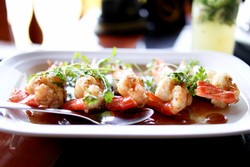 |
 |
| Garlic Prawns | Vegetable Soups |
Drink now or wait?
Contemporary unoaked styles just like our The White Chardonnay is made in an everyday drink now style but can happily hang out in your wine rack for two years. More heavily oaked examples offer more cellaring potential.
Get intimate with The Islander Estate Vineyards The White Chardonnay
Priced for everyday drinking, now is a great time to get your hands on The White. Click on the image below to add some to your shopping cart now.
Take a fresh look at Sauvignon Blanc

It's the white wine in almost every Australian wine fridge during the warmer months. Sauvignon Blanc may be popular but producing high-quality wine requires a skilled winemaker & impeccable timing.
With its huge rise in popularity in recent years, most Australian white wine drinkers have included Sauvignon Blanc in their wine repertoire. There is a lot to learn about this variety which can produce very varied characteristics with a careful winemaking hand.
Here are some facts about one of our favourite varieties you may not know:
- It's no new kid on the wine block. Sauvignon Blanc originated in France in the 1500's the Loire Valley & Jacque Lurton's native Bordeaux, where it features in famous French wines like Sancerre and Pouilly-Fumé.
- Sauvignon Blanc has a wild side. Its name comes from the French words' sauvage' meaning wild and 'blanc' meaning white.
- Sauvignon Blanc in Bordeaux is most known as a major player in the sweet wine Sauternes.
- Bordeaux's most famous white blend, Bordeaux Blanc, pairs Semillon & Sauvignon Blanc in the world's original Sem-Sauv-Blanc blends.
- Believe it or not, Sauvignon Blanc is the mother of the robust tannic red wine variety Cabernet Sauvignon (Cabernet Franc is the father).
- Sauvignon Blanc grows best in cool or maritime climates (both Bordeaux & Kangaroo Island feature maritime environments) where long, even growing conditions balance its crisp acidity with fresh fruit character.
- Sauvignon Blanc was one of the first varieties to be described in terms of one of its dominant flavour compounds, methoxypyrazines. This compound is responsible for the Sauvignon Blanc's herbaceous nature, including characteristics like asparagus, cut grass, capsicum, dried herbs and gooseberries. Next time you taste wine with friends, drop this term!
- Not all Sauvignon Blancs are the same. It can vary wildly based on where it's grown & winemaking techniques, so try a wide range of regions & styles.
- It has an alias. Fumé Blanc –coined in California in the 1960s and popularized by Robert Mondavi. Fumé Blanc is Sauvignon Blanc. Sometimes aged in oak, giving it smoky notes (fumé means smoke), definitely one to try if you are looking for a more textural & complex Sauvignon Blanc.
Looking for foods that pair beautifully with Sauvignon Blanc? Easy, if a squeeze of lemon would enhance the dish, you'll be onto a winner serving them together.
We have minimal quantities of our 2021 Sauvignon Blanc left online & at our Tasting Room, order yours now
Falling in love with Viognier
If you haven't discovered viognier, you're about to fall in love. One of the most beguiling white wines around, it's well worth hunting out producers with a dedication to bringing out its best.
Viognier's Origins
Originating from the Rhône Valley in France, Viognier is the only permitted grape variety in the Rhône appellations of Condrieu and Château Grillet, located on the west bank of the Rhône.
Viognier (pronounced vee-ohn-yay) almost became extinct as recently as the 1980s, when as little as 8 acres remained in France. Thankfully it is now grown more extensively in the Rhone Valley & around the world, including in the USA & Australia.
Yalumba planted the first viognier vines in Australia in 1980. We weren't far behind, including viognier as one of the founding varietals at The Islander Estate Vineyards in 2000, the only viognier grown on Kangaroo Island. We are thrilled that our vines are recovering from the 2020 bushfires.
Viognier is notoriously difficult to grow. It is low yielding, subject to disease & picking must be carefully timed to get the best aromatics & balance of its oily character, so it's a grape grown by viticulturalists with a genuine love for it.
Why we love it
In Australia, viognier is often hidden away in Shiraz, with just a few per cent added to bring fragrance & texture to the red wine. However, we know it is a stunning white wine as a single varietal & can't help but reserve a tiny quantity each year to showcase in our varietal range.
.
Viognier sits in the middle of the scale between delicate unwooded varieties like pinot gris & sauvignon blanc and the richer, often-oaked varieties like chardonnay.
It is medium to full-bodied, dry & often golden in colour. It can be unoaked but most often oaked to add texture, viscosity, spice & a touch of vanilla.
Viognier is a distinctive wine. It has been described as reminiscent of apricots, rose, honeysuckle, ripe peaches & musk. The best are floral & textural, even voluptuous.
Viognier has a distinctive oily character in the mid-palate, which is 'tell' for the variety along with its unique floral & stone fruit aroma.
Viognier's Food Friends
Viognier is a food-friendly wine pairing with a wide range of dishes. Its fragrant characteristic pairs well with spicy Thai herb-based dishes or creamy mild Indian curries, hearty Moroccan & African dishes, freshly grilled seafood or barbecued chicken.
As a textural oaked white wine, serving viognier at the right temperature is important to get the best from its flavour & aroma. We recommend lightly chilling viognier rather than serving it fridge-cold to allow its stunning aromas to come to the forward.
Viognier is also an excellent wine to add to your cellar & age for several years.
How we produce viognier
The Islander Estate Vineyards produced just a single barrel of viognier each year. The grapes are wild fermented in seasoned barrels, cold settled for 24 hours, then the wine is placed in 400 litre seasoned French oak puncheons for ageing, with lees stirring for three months. Malolactic ferment is avoided to preserve freshness and acidity. After ageing, the wine is filtered and hand bottled with only 30 cases produced.
Tasting Notes
COLOUR: Deep Straw
NOSE: Fresh apricots, honey, orange blossom
PALATE: Creamy, viscous middle palate with a slight nuttiness, apricot & dried fruit.
FINISH: A soft textural mouthfeel does not detract from the freshness in the finish.
Reviews
Our new 2021 vintage is yet to be reviewed however, Jenni Port's review of our 2019 vintage for the Halliday Wine Companion tells you all you need to know.
"Archetypal viognier with the scent of honey-drizzled peaches and pears, orange blossom and fruit peel. Intoxicating stuff. Golden and creamy style with a slightly nutty demeanour that lasts to the finish, the apricot stone and dried fruit savouriness complete the textbook example. A wine of many parts and with many years ahead." 95/100 points
Ready to discover viognier? Our 2021 vintage has just been released exclusively to our Discoverer's Wine Club Members.
Click here to order yours.
Secret Autumn Sunset Spots on Kangaroo Island

When summer’s warm weather passes & Anzac Day is over, visitor numbers to Kangaroo Island traditionally slow.
But ‘Islanders’ know the cooler months are some of the most stunning on Kangaroo Island. Warm days, crisp nights, and rains transform dry paddocks into vibrant green almost before your eyes.
And our favourite part? The light in the late afternoon & at sunset is magic. Autumn sunsets are our favourite. We asked our team to share their favourite spots to end the day with a glass of wine.
Yale, Managing Director, Winemaker, Wrangler of Staff

Favourite Sunset Spot? West Bay Beach, Flinders Chase National Park
“I love watching the sun sink behind the horizon into the southern ocean at West Bay. Sitting on the beach with a glass of wine, feeling like you’re at the end of the earth. Such a secluded spot but still totally accessible to anyone willing to make the drive.”
Favourite Sunset Wine? Wally White Semillon
“Our white wine for red wine drinkers. With enough creaminess & texture to go with some rich Australian salmon caught fresh from the beach & cooked in a pan with a little wine over a beach fire”
Image courtesy of Lauren Garret on Instagram
 Sophie, Cellar Door Manager extraordinaire
Sophie, Cellar Door Manager extraordinaire
Favourite Sunset Spot? Flagstaff Hill Lookout, Reeves Point. “Just a few minutes from my home in Kingscote, Flagstaff Hill is a stunning elevated spot for an evening after-work walk to watch the sunset over the Bay of Shoals. With elevated views for almost 360 degrees, there’s no better place to let go of the day.”
Favourite Sunset Wine? Varietal Range Semillon Sauvignon Blanc. “A limited release wine, this is my new favourite for when you want something a little more textural & sophisticated in the white wine spectrum. I’ve visited Jacques in Bordeaux & this reminds me so much of the Bordeaux Blanc blends that I tried there.”
Image courtesy of Ross Evans Photography on Instagram
 Carmen, Cellar Door host with most
Carmen, Cellar Door host with most
Favourite Sunset Spot? Pennington Bay. “Most people visit Pennington Bay in the height of summer to swim & surf. It is absolutely stunning in the cooler months just after a storm when it’s almost deserted & the sunset views are ours alone, it totally refreshes the mind & spirit.”
Favourite Sunset Wine? Boxing Bay Shiraz/Cab Sauv. "I love that this is a European take on a classic Aussie blend. A glass watching the sunset is perfect to ward the chill off & the rest goes down perfectly by the fire when we get home".
Image courtesy of Grant Coutts on Instagram

Sue, Cellar Door Hand, Luxury Accommodation Specialist, Farmer
Favourite Sunset Spot? One Kangaroo Island, Brown Beach
“There is no more luxurious experience on Kangaroo Island than sitting in a warm outdoor bubble bath on a crisp evening, in total privacy, overlooking Brown Beach & the sunset to the west. Unforgettable”
Favourite Sunset Wine? Petiyante
What else is there to drink in an outdoor bath at sunset than a delicious glass of Methode Champenoise sparkling?
Image courtesy of One Kangaroo Island on Instagram
 Tracey, Wrangler of all things financial
Tracey, Wrangler of all things financial
Favourite Sunset Spot? Cygnet River
“In the late afternoon just as dusk descends, the light through the trees surrounding the Cygnet River is something else. And it only happens during the cooler months. It makes you look up from your computer at our Tasting Room, step outside & take a deep breath.”
Favourite Sunset Wine? Tracey’s been drinking Bark Hut Road, Shiraz/Cabernet Franc, our signature blend for 15 years ago. It brings together our French & Australian heritage in a bottle & it suits just about any cool evening dish.
Image courtesy of Cath Williams on Instagram
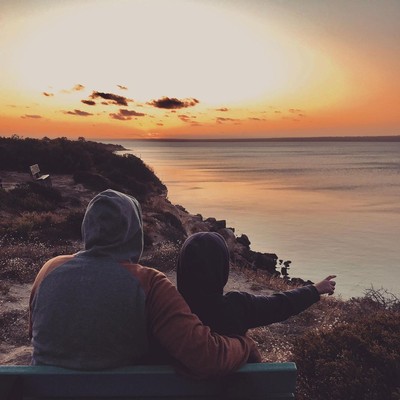 Cath, Marketing & Story Teller
Cath, Marketing & Story Teller
Favourite Sunset Spot? Baudin Beach
“My home, Baudin Beach. We live in a cottage snuggled behind a sand dune. Just near our house is a path along the cliffs with a special chatting seat in honour of a much loved local. After a long day on the social media tools, I can be there with a glass of wine, my partner, daughter & dog in just a couple of minutes. We all take a deep breath & let go of the day. Then back home out of the evening chill & into the warm cosiness of the fire.”
Favourite Sunset Wine? “Old Rowley Shiraz/Grenache I am a grenache fan & absolutely love Old Rowley. Elegant but robust, complex but drinkable. Simply one of my go-to blends & I’m yet to find one I love more than the one we make at The Islander Estate Vineyards.”
Image courtesy of Cath Williams on Instagram
Plan your cool weather visit to Kangaroo Island now
Click to Visit The Islander Estate Vineyards
map of Favourite Autumn Sunset Spots
and
Visit the Tour Kangaroo Island Website
Two to Tango by James Halliday
The Making of The Islander Estate Vineyards
by James Halliday
The Weekend Australian Magazine 9 April 2022
Our thanks to James Halliday and The Weekend Australian magazine for sitting down with Jacques Lurton and Yale Norris to catch up on the stunning recovery of our Kohinoor Hills estate and to share some of our upcoming releases.
Read the article online here & click on the links below to access reviewed wines.
Buy 2018 Boundary Track Shiraz
Buy current vintage 2015 The Independence Malbec (2016 yet to be released)
Buy 2021 Sauvignon Blanc
The Islander Estate Vineyards wines rated by USA Wine Enthusiast
As part of Wine Australia’s US Market Entry Program, a range of our wines were recently reviewed by the Wine Enthusiast’s rating panel. Wines from around the world are tasted by the Wine Enthusiast’s expert tasting panel at their New York Office.
The tasting gives us the opportunity to test how our wines are received by USA wine experts, alongside some of the best from Australia & Europe.
We were really pleased to receive solid results. Our Estate wines were placed in the Highly recommended category, with one of scoring 93 points, a score awarded to less than 1% of all Australian wines tasted by the panel. Our everyday drinking varietal wines also scored in the good value, well-recommended category, exactly where we would place them. Check out the reviews & order a selection for your wine cellar.
Wine Enthusiast Rating Scale
| Classic 98–100 | The pinnacle of quality |
| Superb 94–97 | A great achievement |
| Excellent 90-93 | Highly recommended |
| Very Good 87 - 89 | Often good value, well recommended |
| Good 83 - 86 | Suitable for everyday consumption; often good value |
| Acceptable 80-82 | Can be employed in casual situations |
 2018 Boxing Bay Shiraz-Cabernet Sauvignon
2018 Boxing Bay Shiraz-Cabernet Sauvignon
Dark purple at the core, this supremely ripe wine’s nose bursts in aromas of cassis, oodles of menthol, Black Mission fig and Morello cherry. All at once sweet in fruit and savory in spice, this is a vibrant and slightly baroque wine in aromas and flavors. In structure, it is well-proportioned and seamless, leaving the taster to revel in the complex flavor dimensions. Creamy tannins are juxtaposed by roaring, refreshing acidity. The spicy finish recalls memories of walking through Istanbul’s Spice Market. Buckle up, this is quite a flavor ride. Drink now–2026.
 2019 Bark Hut Rd Syrah-Cabernet Franc
2019 Bark Hut Rd Syrah-Cabernet Franc
This is an energetic, engaging wine with tremendous aromatic appeal and racy palate lift. The nose shows distinctly different aromas with black peppercorn popping up first, followed by a refreshing herbal lift. The palate gorges on popping-ripe blackberry and blueberry fruits. The tannins are strapping but well-placed and the acidity is marked and vibrant. The medium-plus body is nicely weighty with solid extraction but no heaviness. Lovely now, this should evolve nicely in the coming years. Drink now–2025.
 2019 Old Rowley Shiraz-Grenache
2019 Old Rowley Shiraz-Grenache
Sultry on the nose, with graphite and game dominating the blackberry undertones, the palate follows in the same vein. This is definitely one to decant. The palate opens up with time in the glass. Black plums, Dr. Pepper soda and dried wildflowers create a whirlwind of flavor with a solid caramel tone on the medium finish. That finish is also just a touch warm, but if the wine is served at cellar temperature, it will be fine with a hearty meal. The midpalate is a bit cherubesque, but it is nicely framed by sassy acidity and sculpted tannins. Drink now–2024.
 2021 Sauvignon Blanc
2021 Sauvignon Blanc
This is a snappy, youthful and delightfully intricate white. It shows classic Sauvignon Blanc aromatic markers of ripe yellow citrus and fresh green beans while offering a solidly ripe core balanced by roaring acidity. Hints of sweet and savory spice grace the pretty fruit on the medium finish, which is flecked with crushed slate. Lovely now, this should hold nicely in the bottle for a couple more years. Drink now–2024
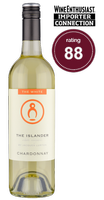 2020 The White Chardonnay
2020 The White Chardonnay
This wine is rambunctious and inviting on the nose. Generous in floral perfume, it also reveals honeydew melon, green gauge plum and toasty baking spice. Nicely rounded on the midweight palate, the buttery undertones are a bit domineering for the reserved, lighter fruit flavors that finish with moderate length. Still, the pleasant mix of tropical fruit and sweet spice influence is an attractive profile that will appease a wide sphere of consumers. Drink now–2024.
2021 The Red Shiraz
This wine’s vivid aromas are a dance party for the nose. Sassy red and black cherries and plums pop out of the glass along with a spray of black peppercorns and an undercurrent of hard-stemmed herbs. The attack is a burst of perfectly ripened fruits with acidic verve and streamlined tannins. Nicely extracted but not unctuous, and neither cloying nor heavy, this shimmies across the palate with incredibly energetic, youthful fruit. Given the fairly fast finish, this crowd-pleaser is perfect for casual settings. Drink now–2024
Shop a selection of Wine Enthusiast's favourites
A year in our Kangaroo Island vineyard - Summer
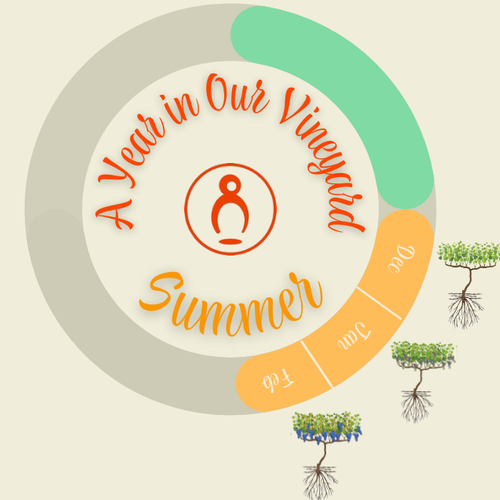
Our annual vintage may last just a few weeks, but it takes an entire year of hard work to ensure we are harvesting the best possible grapes.
Come with us for a guide to a year in our vineyard – one season at a time.
The Summer wine growing season on Kangaroo Island
Spring may be when the vineyard bursts from dormancy back to life, but Summer is when things begin to get exciting, giving us a glimpse towards the potential of the next vintage.
Summer is the season that can make or break vintage. The climate on Kangaroo Island in early summer can still be variable. Optimum conditions for a good vintage are warm, dry days with mild winds. Excessive rain, wine or humidity can all spell disaster.
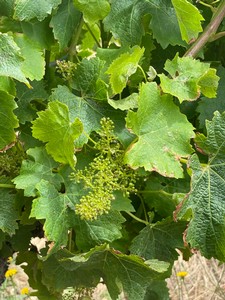 Fruit Set (Dec)
Fruit Set (Dec)
As flowering begins to end, the fertilised flowers start to develop a seed and grape berry to protect the seed. This stage is critical as it determines the potential crop yield.
Now is the time we begin to get a good idea of bunch development and quality on the vine with an insight into how vintage may shape up if the weather remains at optimum conditions.
At this stage of the growing season when we pray for warm sunny days, moderate frost-free nights, gentle breezes and little or no rain.
 Véraison (January)
Véraison (January)
During January, the tiny bunches of grapes go through a rapid period of growth. Once they reach around half their final size, they enter the stage of véraison, usually around 40 – 50 days after fruit set. However, the grapes remain hard, have very little sugar & are high in organic acids.
Throughout véraison the berries begin to ripen, turning from green and begin to turn purple, red and golden. This tipping point is when the vine begins to turn its energy away from vine growth concentrating on developing sweetness in the grapes.If necessary, leaf thinning is undertaken to allow the grapes more access to light & increase airflow to minimise disease risk.
Berry Ripening (February)
After véraison the grapes swell & fill with water. During this ripening period, sugar levels rise & acid levels drop. Colour pigments, flavour compounds & tannins develop. Watering stops to induce mild water stress, inhibit shoot growth & encourage concentrated character in the ripening grapes.
A close eye is kept on the vineyard & when flocks of marauding birds arrive, nets are installed across the vineyard to protect the crop. Once nets are on, vintage is only a matter of weeks away.
Many regions begin vintage in February, however in the cooler conditions on Kangaroo Island, wine vintage traditionally begins a few weeks after other South Australian regions, often in March.
We look forward to continuing to share the journey towards Vintage 2022
Follow our social media channels:
Facebook
Instagram
Subscribe to receive our news & wine offers
Life Springs: 2 years on from the Kangaroo Island bushfires
Two years ago this week, the unimaginable happened to a community already reeling from the worst bushfire disaster Kangaroo Island had ever known.
A lot has happened in the world since January 2020. But for many on Kangaroo Island, recovery is still very real & will be for a long time to come.
Today, we take a look back at how far we've come with some images from immediately after the fire & today. It's only with the benefit of hindsight that we can see what an incredible journey it has been. What Mother Nature takes away, she gives back.
Huge credit to Yale Norris who has lived this disaster every single day, who believed we could recover & put in the immense work to help it happen. And to Jacques Lurton who is so committed to his business here.
Our vineyard is recovering in stages, full production is still a year or two away but come March we will be picking fruit - a major milestone.
Our gratitude to our many customers who have kept us in business & recovering with their support. You each have a hand in our recovery.
If you have a moment this week, jump online & purchase from a small business impacted by fire in your area. The world may have moved on, but they are still dealing with the impact & your support means the world.
Bring on Vintage 2022!

Aerial view of our Estate immediately after January 2020 fires & today.
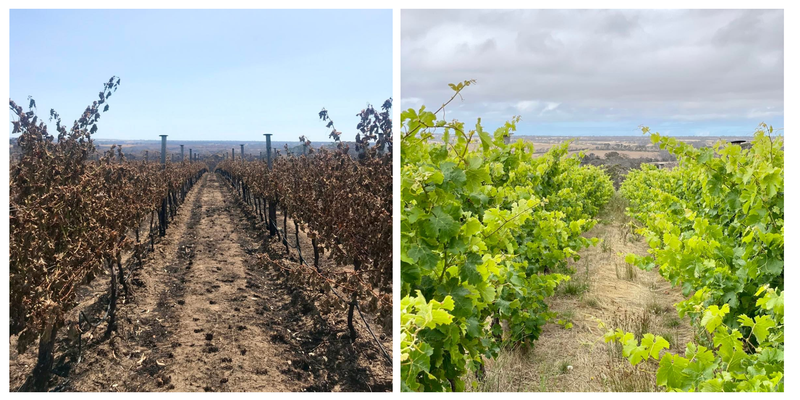 Cabernet Franc vines January 2020 & January 2022
Cabernet Franc vines January 2020 & January 2022
 Bush vine Grenache January 2020 & January 2022 at The Islander Estate vineyards
Bush vine Grenache January 2020 & January 2022 at The Islander Estate vineyards

Regrowth of the remnant native bush which overs almost 30 percent of our estate





